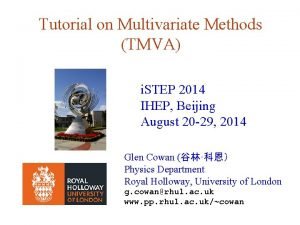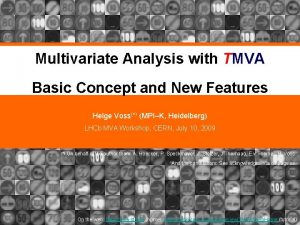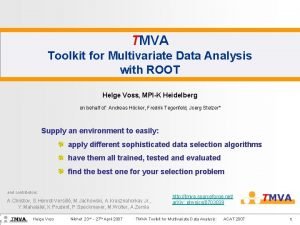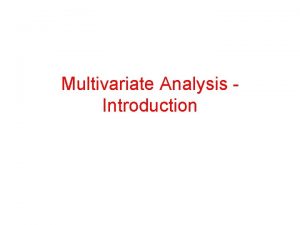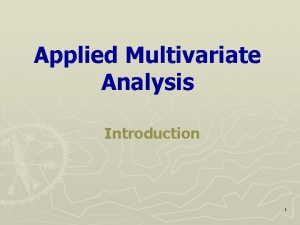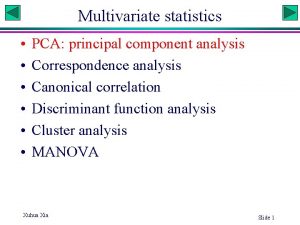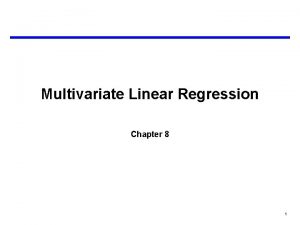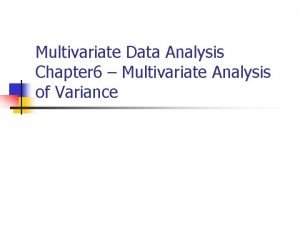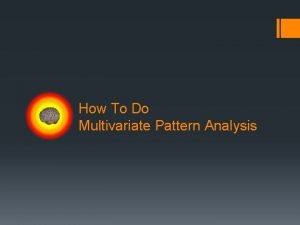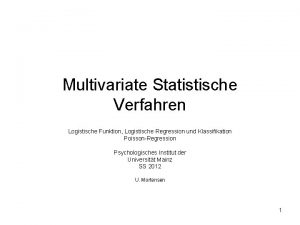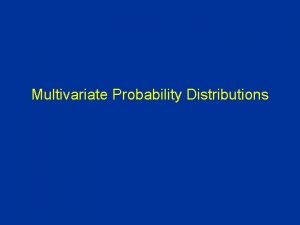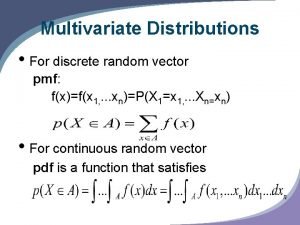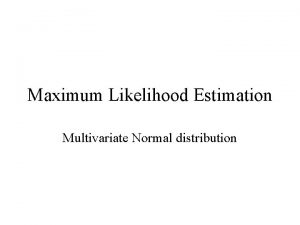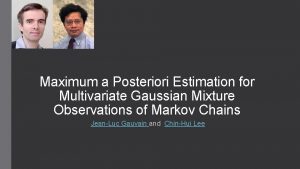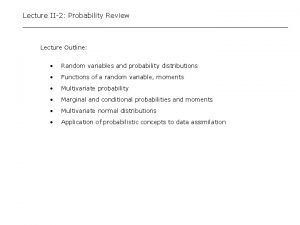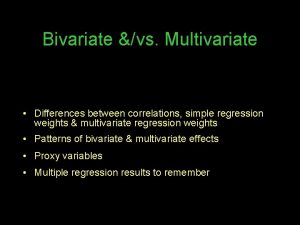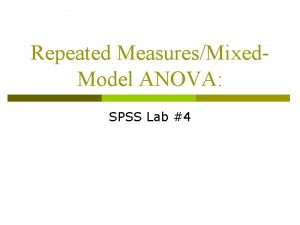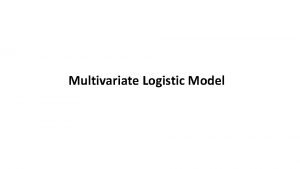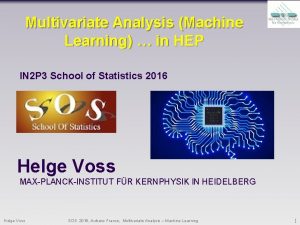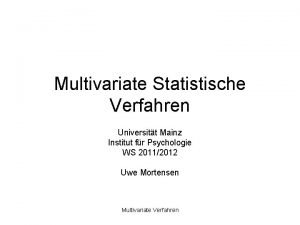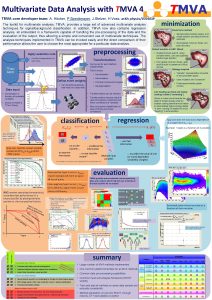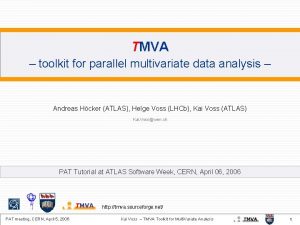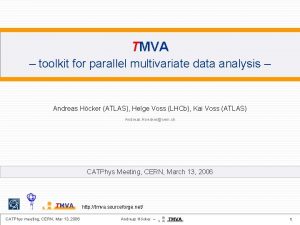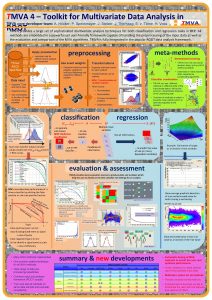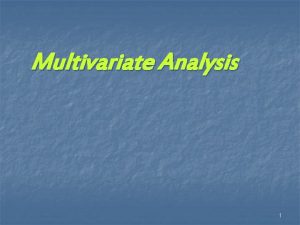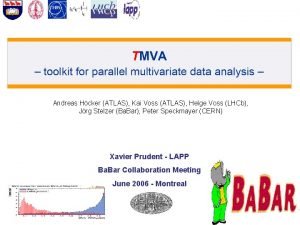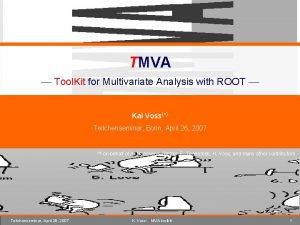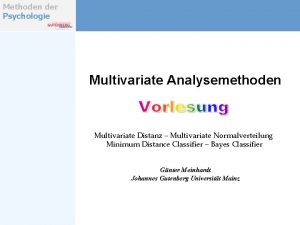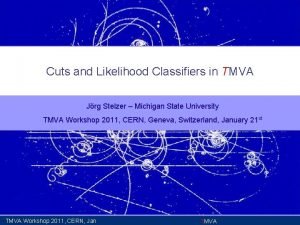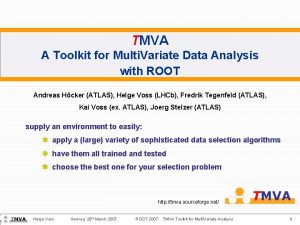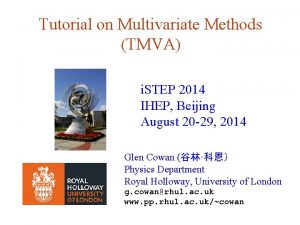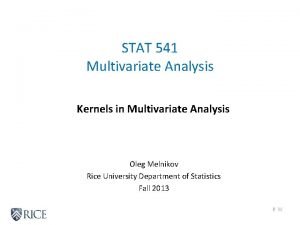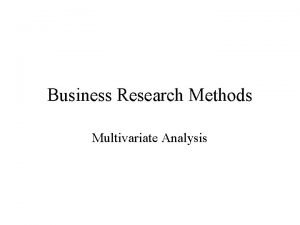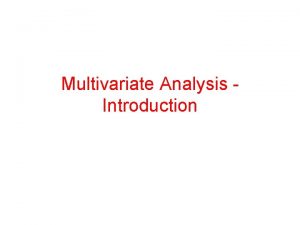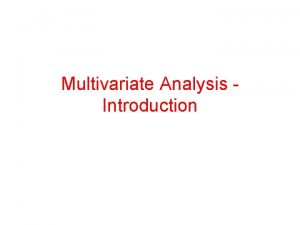TMVA A Multivariate Analysis Toolkit Andreas Hcker Jrg
























- Slides: 24

TMVA A Multivariate Analysis Toolkit Andreas Höcker, Jörg Stelzer, Fredrik Tegenfeldt, Helge Voss Core Developers Matthew Jachowski, Attila Krasznahorkay, Yahir Mahalalel, Xavier Prudent, Peter Speckmayer Contributors

– Introduction – Event classification is main objective of data mining in HEP Signal vs background event separation, particle ID, flavor-tagging, … Can have many input variables (between ~10 to ~50), often correlated Many classification methods exist and are already used in HEP (BABAR almost all analysis use MVA methods) HEP tradition: rectangular cuts (with previous de-correlation) optimization often by hand Also widely accepted: Likelihood (usually in one or two dimensions only) Somewhat new: multidimensional Probability Density Estimators – range search Gaining Trust: Artificial Neural Networks Simple, but can be powerful: Fisher Discriminant (BABAR, BELLE: B selection) Newcomers: Boosted Decision Trees (Mini. Boone, D 0) Powerful new method from Friedman: Rulefit (Study at ATLAS) Uprising: Support Vector Machines (studies for LEP and Tevatron top analysis) Two Problems Skepticism: black box myth, how to evaluate systematics Choice of method: by simplicity, availability, hearsay, limited comparison ATLAS Statistics Workshop 9/24/2021 Jörg Stelzer 2

– What is TMVA – Ideally, for a given problem all MVA methods should be tested Systematically chose the best performing classifier Becoming familiar and gaining experience with other MVA methods takes away the mysticism TMVA – Toolkit for Multivariate Analysis: Framework for parallel training and evaluation of MVA techniques to guide the user to choose of the best signal-background discriminator for his purpose TMVA does not seek to promote any particular classifier, the judgment is up to the user Currently Supported Methods Cuts (optimizers: MC sampling, Genetic alg, simulated annealing) 1 -dimensional Likelihood Estimator Multi-dimensional Probability Density Estimator (range search) Fisher Discriminant (also H-matrix (χ2 -estimator)) Artificial Neural Network (3 different implementations) Boosted/bagged Decision Trees Rulefit Transformation of input variables: decorrelation, PCA ATLAS Statistics Workshop 9/24/2021 Jörg Stelzer 3

– What does TMVA do Exactly – The analyst provides: Training and testing data for signal and background ROOT tree of text file with events List of variables to be included in the analysis List of MVA methods to be used TMVA analysis provides: Training, testing and evaluating all user-selected MVA-methods Graphical and numerical evaluation available guide user’s choice Ranking of input variables Preliminary general ranking Method specific ranking Training results are written to self-contained ‘weight’-files Weight files also contain the complete training setup of a method Easy to share an analysis setup with colleagues ! – no need to send code fragments and explanations back and forth For data analysis (after successful training and selection of MVA) weight file is used by TMVA: : Reader class for classification ATLAS Statistics Workshop 9/24/2021 Jörg Stelzer 4

– TMVA Development and Distribution – TMVA is a sourceforge (SF) package to accommodate world-wide access home page …………………. . http: //tmva. sourceforge. net/ SF project page ……………. . http: //sourceforge. net/projects/tmva view CVS …………. http: //tmva. cvs. sourceforge. net/tmva/TMVA/ mailing lists …………………. . http: //sourceforge. net/mail/? group_id=152074 ROOT: : TMVA class index…. . http: //root. cern. ch/root/htmldoc/TMVA_Index. html Very active project fast response time on feature requests (or bug reports) Currently 4 main developers at CERN, ~23 registered contributors at SF Written in C++ using core ROOT functionality Integrated and distributed with ROOT since ROOT v 5. 11 -03 Available out of the box (ROOT is everywhere) Only thoroughly tested TMVA versions in ROOT Always with up-to-date example in $ROOTSYS/tmva/test/ Documentation currently being written, release date next week ATLAS Statistics Workshop 9/24/2021 Jörg Stelzer 5

– TMVA Technical Details – TMVA can be used C++ executable: (athena), examples Source. Forge CINT macros: examples at $ROOTSYS/tmva/test/ Python (Py. ROOT), example only at Source. Forge Modular Can switch on/off each method Simultaneously train multiple instances of one method with different options Flexible Configuration of methods through custom option strings Input variables (can be formulas as in TTree: : Draw command) Arrays are handled (“p”), but not array indices at present (“p[0]”) User friendly Option names easy to interpret Default options are already good choice to start with Graphical training and evaluation output (macros provided) Once trained, classification to real data straight forward C++/CINT example at $ROOTSYS/tmva/test/TMVApplication. C ATLAS Statistics Workshop 9/24/2021 Jörg Stelzer 6

The Methods in TMVA ATLAS Statistics Workshop 9/24/2021 Jörg Stelzer 7

Decorrelation of Input Variables Cuts and projective likelihood perform best/optimal if there is no correlation between input variables Remove linear correlations between input variables by rotation of parameter space Diagonalize (S) the covariance matrix C D Transform (ST) the square root of D C’ Decorrelate input space x with C’-1 x’ Separate transformation for signal and background De-correlation only complete if input variables are Gaussian Correlations are linear In practice the gain is often only modest ATLAS Statistics Workshop 9/24/2021 Jörg Stelzer 8

Cuts Intuitive and most simple method: cut a rectangular volume out of parameter space that defines the signal Training samples do often not contain realistic signal and background abundance no direct optimization for significance Instead scan signal efficiency [0, 1] and maximize background rejection Straight forward computation of optimal working point (highest significance) given S and B expectation Cut optimization: MINUIT fit (simplex) was found not to be reliable Three different (robust) methods 1. Monte Carlo sampling: random scanning of parameter space inefficient for large number of input variables 2. Genetic algorithm: Preferred method Samples of cut-sets (a population) are evaluated and the fittest individuals are crossbred (including mutation) to create the new generation 3. Simulated annealing: still need to optimize its performance slow cooling of a metal makes atoms move into lowest energy state, simulated by a energy dependent perturbation probability to recover from local minima ATLAS Statistics Workshop 9/24/2021 Jörg Stelzer 9

Projected Likelihood Estimator Probability density functions for all variables combined (for signal and for background) to form likelihood-ratio estimator Reference PDF Optimal MVA approach, if variables are uncorrelated In practice rarely the case, solution: de-correlate input or use different method Reference PDFs are automatically generated from training data and represented as histograms (counting) or splines (order 2, 3, 5) – unbinned kernel estimator in work Output of likelihood estimator often strongly peaked at 0 and 1. To ease output parameterization TMVA applies inverse Fermi transformation. ATLAS Statistics Workshop 9/24/2021 Jörg Stelzer 10

Multidimensional PDE Extend the one-dimensional approach to n dimensions (n – number of input variables) Carli-Koblitz Range-Search: Searches a volume around event and counts(&weights) signal and background reference events (training sample) this volume (n. S/B) Volume: Size: can be fixed (defined by the data: % of Max-Min or RMS) or adaptive (define by number of events in search volume) Shape: box or ellipsoid Weights as function of the (normalized) distance between test- and reference events in volume can be applied (linear or Gaussian) Practical challenges: Need very large training sample (curse of dimensionality of kernel based methods) Fast training, slow evaluation. Speed up range search by sorting reference sample into binary search trees ATLAS Statistics Workshop 9/24/2021 Jörg Stelzer 11

Linear Fisher Discriminant Well-known, simple and elegant MVA method Linear discriminant analysis determines a axis in the input variable hyperspace (F 1, …, Fn, such that a projection of events on this axis pushes signal and background as far away from each other as possible Optimal for linearly correlated Gaussian variables where S and B have different means No separation power from variables v with different shapes but the same mean Fv=0 W: sum of S and B covariance matrices Fisher Coefficient H-matrix estimator: poor man’s variation of Fisher discriminant ATLAS Statistics Workshop 9/24/2021 Jörg Stelzer 12

Artificial Neural Network (ANN) ANNs are non-linear discriminants Non linearity from activation function. (Fisher is an ANN with linear activation function) v 0 y 0 v 1 y 1 Multilayer perceptron: fully connected, feed forward, 1. . NH hidden layers vn yn v’j y’j wn Typical activation function y’j Training of an MLP: back-propagation method Randomly feed signal and background events to MLP and compare the desired output {0, 1} with the received output (0, 1): ε = d - r Correct weights, depending on ε and learning rate η ATLAS Statistics Workshop 9/24/2021 w 1 . . . Can approximate every continuous function to arbitrary precision with just one layer and infinite nodes (Weierstrass) w 0 Jörg Stelzer v’j 13

(Boosted) Decision Trees Tree structure classifier (S and B leafs) Classifies events by following a sequence of decisions depending on the events variable content until a S or B leaf ROOT-Node S, B Training the tree: e. g. split minimizes Gini-index S, B S 1, B 1 S 2, B 2 other splitting criteria: significance, cross-entropy, misclassification error Leaf-Node S 1 < B 1 Node S 2, B 2 Bkg Decision trees are robust in many dimensions but by itself not powerful (similar to cuts) Need to boost Method to combine classifiers: boosting (also implemented: bagging) Leaf-Node S 4 > B 4 Node S 3, B 3 Signal Developed by statisticians in last decade Boosting: (Adaboost) Re-weight events, higher weight for misclassified events, Leaf-Node S <B lower for correctly classified events Bkg Retrain and repeat set of classifiers Classify data by a weighted vote of the classifiers 5 ATLAS Statistics Workshop 9/24/2021 Jörg Stelzer 5 Leaf-Node S 6 > B 6 Signal 14

Rulefitter New and powerful method of J. Friedman Belongs to the class of combined classifiers This one combines decision trees from a ‘random forest’ Also adds a linear discriminant (Fisher) term Random subsets of training data used to create random forest of decision trees (ym) Coefficients am are then fitted Friedman, Popescu, “Gradient Directed Regularization for Linear Regression and Classification”, Technical report, statistics department, Stanford University 2003 ATLAS Statistics Workshop 9/24/2021 Jörg Stelzer 15

HOWTO use TMVA ATLAS Statistics Workshop 9/24/2021 Jörg Stelzer 16

– Training (from TMVAnalysis. C) – //--create the root output file Factory : Evaluation results ranked by best 'signal eff @B=0. 10' TFile* target = TFile: : Open( "TMVA. root", "RECREATE" ); --- Factory : --------------------------------------- Create the Factory --- Factory : MVA Signal efficiency (error): Signifi- Sepamu-Trans--Factory : Methods: @B=0. 01 @B=0. 10 @B=0. 30 cance: ration: form: // create the factory object --- Factory : --------------------------------------TMVA_Factory *factory = new TMVA_Factory( “Project", target, "" ); --- Factory : Fisher : 0. 292(07) 0. 690(07) 0. 900(04) 1. 261 0. 484 0. 991 --- Factory : Likelihood. PCA : 0. 245(06) 0. 684(07) 0. 896(04) 1. 330 0. 477 0. 867 --- Factory : MLP : 0. 287(07) 0. 682(07) 0. 903(04) 1. 328 0. 483 0. 991 TFile * input = TFile: : Open("tmva_example. root"); --- Factory : Likelihood. D : 0. 287(07) 0. 673(07) 0. 898(04) 1. 331 0. 480 0. 861 TTree *signal = (TTree*)input->Get("Tree. S"); --- Factory : HMatrix : 0. 075(04) 0. 663(07) 0. 884(05) 1. 179 0. 451 0. 991 TTree *background: = PDERS (TTree*)input->Get("Tree. B"); --- Factory : 0. 225(06) 0. 646(07) 0. 878(05) 1. 258 0. 449 0. 911 --- Factory : BDT : 0. 200(06) 0. 641(07) 0. 872(05) 1. 219 0. 432 0. 991 --- Factory : Rule. Fit : 0. 245(06) 0. 632(07) 0. 882(05) 1. 246 0. 451 0. 901 factory->Set. Input. Trees( signal, background, s. Weight, b. Weight); --- Factory : Cuts. GA : 0. 262(06) 0. 622(07) 0. 868(05) 0. 000 factory->Add. Variable("var 1+var 2", 'F'); factory->Add. Variable(“var 1 -var 2", 'F'); --- Factory : Likelihood : 0. 155(05) 0. 538(07) 0. 810(06) 0. 983 0. 353 0. 767 factory->Add. Variable("var 3", 'F'); factory->Add. Variable("var 4", 'F'); --- Factory : ---------------------------------------- Factory : factory->Book. Method( TMVA: : Types: : k. Cuts, "Cuts. D", --- Factory : Testing efficiency compared to training efficiency (overtraining check) "!V: MC: Eff. Sel: MC_NRand. Cuts=200000: Var. Tranform=Decorrelate" ); --- Factory : ---------------------------------------- Factory : MVA Signal efficiency: from test sample (from traing sample) --Factory : Methods: @B=0. 01 @B=0. 10 @B=0. 30 factory->Book. Method( TMVA: : Types: : k. Likelihood, "Likelihood. PCA", --- Factory : --------------------------------------"!V: !Transform. Output: Spline=2: NSmooth=5: Var. Transform=PCA"); --- Factory : Fisher : 0. 292 (0. 235) 0. 690 (0. 655) 0. 900 (0. 892) --- Factory : Likelihood. PCA : 0. 245 (0. 222) 0. 684 (0. 677) 0. 896 (0. 891) //--Train all configured MVAs using the: set of training Factory : MLP 0. 287 (0. 232) events 0. 682 (0. 661) 0. 903 (0. 895) factory->Train. All. Methods(); --- Factory : Likelihood. D : 0. 287 (0. 245) 0. 673 (0. 664) 0. 898 (0. 889) --- Factory : HMatrix : 0. 075 (0. 058) 0. 663 (0. 645) 0. 884 (0. 877) --Factory : PDERS : 0. 225 (0. 335) 0. 646 (0. 674) 0. 878 (0. 884) // Evaluate all configured MVAs using the set of test events --- Factory : BDT : 0. 200 (0. 240) 0. 641 (0. 750) 0. 872 (0. 892) factory->Test. All. Methods(); --- Factory : Rule. Fit : 0. 245 (0. 242) 0. 632 (0. 621) 0. 882 (0. 872) --- Factory : Cuts. GA : 0. 262 (0. 183) 0. 622 (0. 607) 0. 868 (0. 861) //--Evaluate and compare performance: of 0. 155 all configured Factory : Likelihood (0. 137) MVAs 0. 538 (0. 526) 0. 810 (0. 797) --Factory : --------------------------------------factory->Evaluate. All. Methods(); Tell the Factory about your data d ho t e es s o r e s U // open the GUI for the root macros TMVAGui(); ATLAS Statistics Workshop 9/24/2021 m t s be Book desired e methods/options th o h c Perform training and evaluation Open the GUI for performance plots Jörg Stelzer 17

– Application (from TMVApplication. C) – // create the Reader object TMVA: : Reader *reader = new TMVA: : Reader(); // create a set of variables and declare them to the reader Float_t var 1, var 2, var 3, var 4; reader->Add. Variable( "var 1+var 2", &var 1 ); reader->Add. Variable( "var 1 -var 2", &var 2 ); reader->Add. Variable( "var 3", &var 3 ); reader->Add. Variable( "var 4", &var 4 ); Create the Reader Declare the variables that will hold your data . ) c t reader->Book. MVA( "BDT method", Chose e the MVA , s “weigths/Project_BDT. weights. txt" ); you like best ie is method d s u ly st a TTree* the. Tree = (TTree*)input->Get("Tree. S"); an atic Float_t user. Var 1, user. Var 2; r e the. Tree->Set. Branch. Address( "var 1", &user. Var 1 ); Prepare the user th tem r s u the. Tree->Set. Branch. Address( "var 2", &user. Var 2 ); f sy data r the. Tree->Set. Branch. Address( "var 3", &var 3 ); fo ld, e ie the. Tree->Set. Branch. Address( "var 4", &var 4 ); Us l y na g // loop over user data si r for (Long 64_t ievt=0; ievt<the. Tree->Get. Entries(); ievt++) { fo t i the. Tree->Get. Entry(ievt); Analyze the user data, F ( var 1 = user. Var 1 + user. Var 2; fill histogram, etc. var 2 = user. Var 1 - user. Var 2; hist. Bdt ->Fill( reader->Evaluate. MVA( "BDT method") ); } ATLAS Statistics Workshop 9/24/2021 Jörg Stelzer 18

TMVA – an example ATLAS Statistics Workshop 9/24/2021 Jörg Stelzer 19

– Toy Example – Also with SF and ROOT – Simple toy to illustrate the strength of the de-correlation technique 4 linearly correlated Gaussians, with equal RMS and shifted means between signal and background All plots from GUI ATLAS Statistics Workshop 9/24/2021 Jörg Stelzer 20

Decorrelation of Training Input Scatter plot pf all pairs of input variables (and profile) Decorrelation procedure can be applied before training ATLAS Statistics Workshop 9/24/2021 Jörg Stelzer 21

Likelihood and Cuts Improvement On linearly correlated variables Fisher is already the optimum Decorrelation of input: LH and Cuts comparable with Fisher ATLAS Statistics Workshop 9/24/2021 Jörg Stelzer 22

More Information All MVA outputs LH reference distributions BDT visual ANN information ATLAS Statistics Workshop 9/24/2021 Jörg Stelzer 23

Summary TMVA is now a mature package User feedback from many HEP collaborations (including neutrino physics) Integration into ROOT essential Emphasis on consolidating and improving current methods as well as the TMVA framework Providing user interface to Athena (AOD, Event. View analyses) Standalone application of methods New methods are being developed Support vector machine Bayesian Classifier Committee method Optimizes arbitrary combinations of MVA methods ATLAS Statistics Workshop 9/24/2021 Jörg Stelzer 24
 Process hcker
Process hcker Tmva tutorial
Tmva tutorial Tmva courses
Tmva courses Tmva user guide
Tmva user guide Multivariate analysis
Multivariate analysis Manova definition
Manova definition Nature of multivariate analysis
Nature of multivariate analysis Multivariate analysis of variance and covariance
Multivariate analysis of variance and covariance Multivariate analysis
Multivariate analysis Multivariate statistical analysis
Multivariate statistical analysis Multivariate analysis
Multivariate analysis Multivariate analysis
Multivariate analysis Multivariate pattern analysis
Multivariate pattern analysis Multivariate logistische regression
Multivariate logistische regression Multivariate binomial distribution
Multivariate binomial distribution Multivariate pdf
Multivariate pdf Multivariate regression spss
Multivariate regression spss Likelihood function
Likelihood function Maximum a posteriori estimation for multivariate gaussian
Maximum a posteriori estimation for multivariate gaussian Multivariate pdf
Multivariate pdf Bivariate vs multivariate
Bivariate vs multivariate Mixed design anova spss
Mixed design anova spss Normal equation logistic regression
Normal equation logistic regression Multivariate methods in machine learning
Multivariate methods in machine learning Multivariate verfahren psychologie
Multivariate verfahren psychologie

